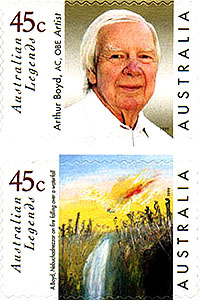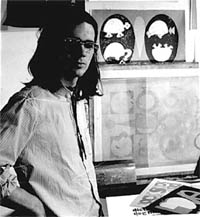|

Boyd was born in Melbourne 1920 into a potting and painting family where his talent was nurtured. He first visited London in 1959, and after that divided his time between England and Australia, a task made more difficult because he refused to fly.
I had a brief powerful encounter with Boyd, when I was a young poet in exile from the Australian government's hope to lock me in gaol for two years because I, like thousands of others, had not registered for what was euphemistically called 'national service' in Vietnam. It was conscription, the draft. Australia, unlike Britain, was a willing participant in the United States' disgusting folly in Vietnam and participating in a losing cause, but with 'only' 500 dead, including many conscripts. This was a drop of blood compared to the United States 50,000, but it continued to have a resonant effect in Australia - and in London with the expatriate radicals.
I spent most of 1969 in London, arriving, symbolically I thought, just a few days before man walked on the moon. I needed some months to think about what to do - with my life, poetry, the revolution and the whole damn thing. I eventually decided to return to Australia and take my chances with the inefficiency of the government and the perverted logic of the court system.
While there I met and for a brief time 'hung out' with some of the children of Arthur Boyd and another terrific Australian painter, John Perceval, and helped Arthur hang the three exhibitions he had running that year in London. Paintings at Tooths in Bruton Street, etchings and lithographs at Maltzahn Gallery, and tapestries and drawings at Hammet Gallery, both nearby in Cork Street.
The paintings seemed to be made under the influence of Mahler's mighty Resurrection Symphony, which you could hear booming up from the cellar-studio in Highgate where Arthur was still at work up to the day of hanging. Some of the heavily impasto-ed flourishes and touch ups were wet when we hung them.
The Nebuchadnezzar paintings are inspired by the notion that the builder of Babylon and the great King of Chaldea also had a Lear-like mad experience in the wilderness where he was touched by God. And also, appropriate to my circumstance, by the suicide deaths by burning of monks in Vietnam, Jan Palach in Czechoslovakia and a number of people, now sadly forgotten in the United States.
But I was less inspired by the greatness of these paintings (though they had a wonderfully apocalyptic feeling about them) than by the sights and sounds of the artist at work. Arthur was just 49 years old then, the same age as I am now. To me he seemed a wise old man; writing this I feel as young and dumbstruck as I did then.
When I heard about Arthur's death, I thought again of my brief meeting thirty years ago. I remembered that I had written a poem, after a conversation at breakfast one morning. It is reproduced below.
|
|

